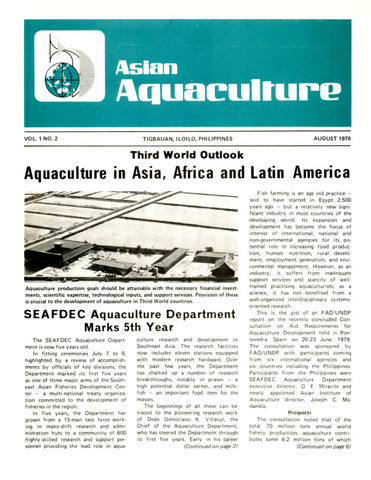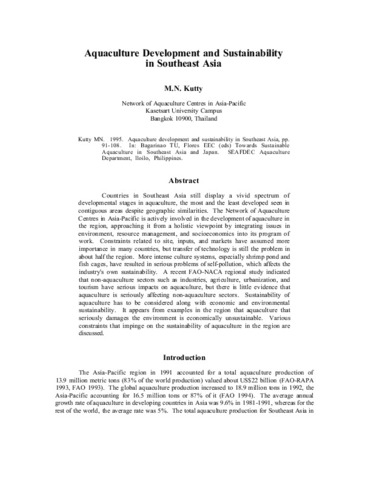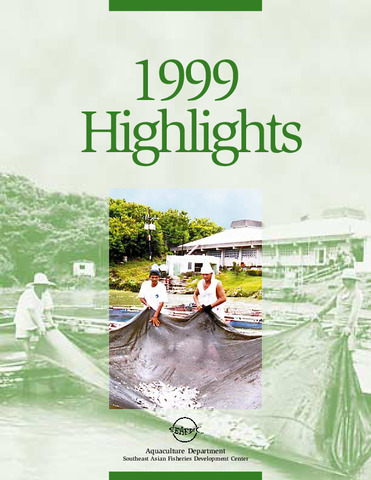Subsistence aquaculture and technology transfer among developed and developing countries
| dc.contributor.author | Madamba, Joseph C. | |
| dc.date.accessioned | 2024-02-28T02:53:45Z | |
| dc.date.available | 2024-02-28T02:53:45Z | |
| dc.date.issued | 1979-03 | |
| dc.identifier.citation | Madamba, J. C. (1979). Subsistence aquaculture and technology transfer among developed and developing countries. Proceedings of the World Mariculture Society, 10(1–4), 182–193. https://doi.org/10.1111/j.1749-7345.1979.tb00017.x | en |
| dc.identifier.issn | 0748-3260 | |
| dc.identifier.uri | http://hdl.handle.net/10862/6519 | |
| dc.description.abstract | Subsistence-level and small-scale aquaculture systems dominate the aquaculture industry of most developing countires. Characterized by low material and management inputs, low level of technology, and low output, subsistence-level aquaculture is a system of farming that gives an inadequate economic return to the operator. It is argued that subsistence-level and small-scale aquaculturists must be given adequate government attention and institutional support: first, because these farming systems can be greatly improved; second, because they provide employment opportunities for the rural poor; and third, because aquaculture is a potential significant source of protein food for the poorer majority. The status of aquaculture in several developing countries is reviewed. Small-scale fishfarming characterized by traditional practices predominates in India, Bangladesh, Indonesia, Nepal, Thailand, Malaysia, and the Philippines. The pattern is similar in some African countries like Nigeria, Kenya, and the Sudan. A socioeconomic profile of the small fishfarmer is drawn. Aside from his low level of application of production and management inputs and his low output, he is highly susceptible to the vagaries of the market. His capacity to acquire improved technology on his own is low. To augment his earnings, he works in non-aquaculture occupations. The paper calls for a policy as well as a research and development bias for the subsistence fishfarmer. An aquaculture industry development support model is presented and a pilot-scale implementation scheme of this model is described. Finally, a mechanism is described for the transfer of local and borrowed aquaculture technology within a given country and among countries. | en |
| dc.language.iso | en | en |
| dc.publisher | Louisiana State University | en |
| dc.subject.lcsh | Developing countries | en |
| dc.subject.lcsh | Aquaculture industry | en |
| dc.subject.lcsh | Aquaculture--Technology transfer | en |
| dc.title | Subsistence aquaculture and technology transfer among developed and developing countries | en |
| dc.type | Article | en |
| dc.identifier.doi | 10.1111/j.1749-7345.1979.tb00017.x | |
| dc.citation.volume | 10 | en |
| dc.citation.issue | 1-4 | en |
| dc.citation.spage | 182 | en |
| dc.citation.epage | 193 | en |
| dc.citation.journalTitle | Proceedings of the World Mariculture Society | en |
| dc.subject.asfa | developing countries | en |
| dc.subject.asfa | small-scale aquaculture | en |
| dc.subject.asfa | subsistence fisheries | en |
| dc.subject.asfa | aquaculture | en |
| dc.subject.asfa | technology transfer | en |
このアイテムのファイル
| ファイル | サイズ | フォーマット | 閲覧 |
|---|---|---|---|
|
このアイテムに関連するファイルは存在しません。 |
|||
このアイテムは次のコレクションに所属しています
-
Journal Articles [1256]
These papers were contributed by Department staff to various national and international journals.



